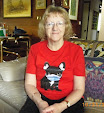

I have been collecting swap cards since I was a child at primary school in the 1950's. A few years ago I heard about the Melbourne Playing Cards Collectors (see link on the sidebar here), so I joined them, and have increased my collection substantially!

